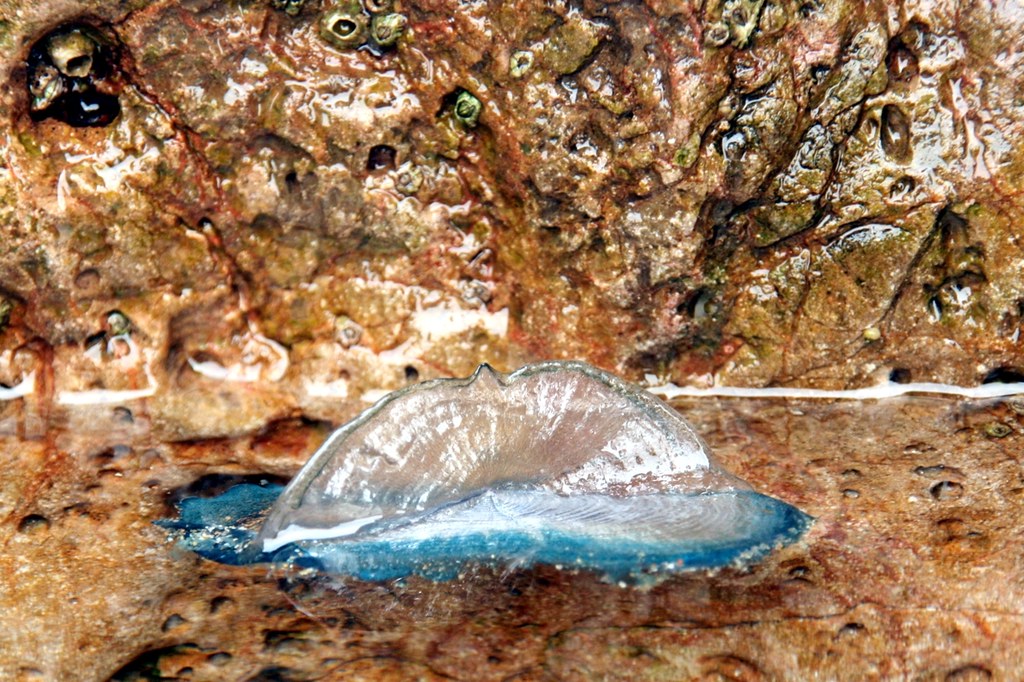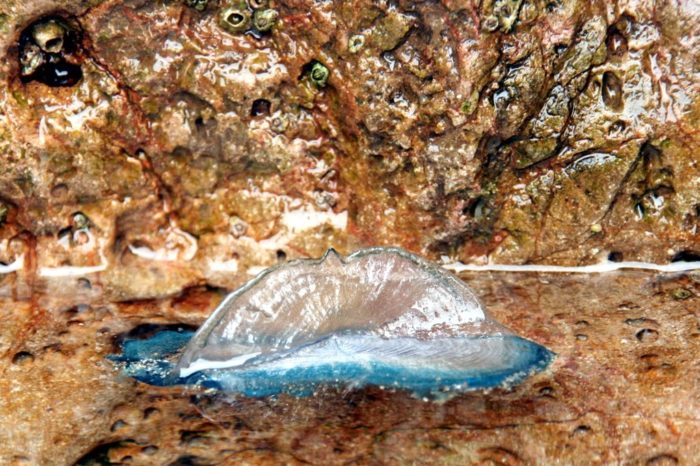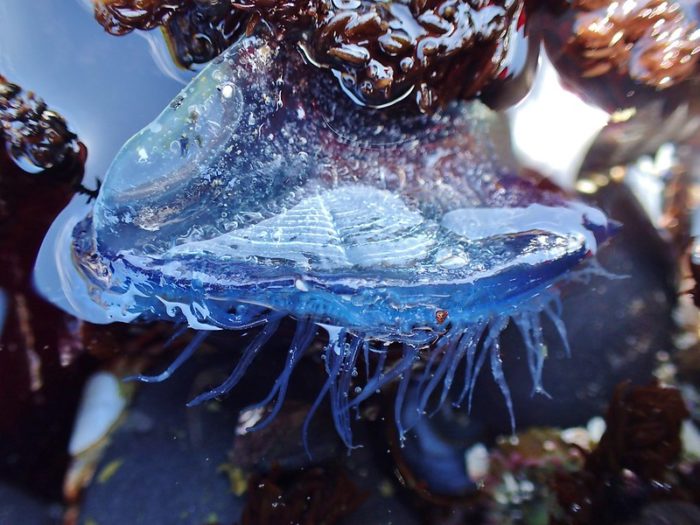
Sea Wonder: By-the-Wind Sailor

Photo credit: Piers Nye
Set your sails for adventure with the By-the-Wind Sailor jellyfish! By-The-Wind sailors float along at the mercy of the sea breeze in nearly all corners of the world’s ocean. Interestingly, individual sailor jellies are comprised of a colony of organisms that share a digestive system. Their stinging cells only stun their small planktonic prey, but beachgoers that see sailor jellies along the beach should admire their beauty without touching – the mild stings still sting!
Description
By-the-wind sailor jellies (Velella velella) belong to the class hydrozoans, the same group as jellyfish, classified by their gelatinous arms and stinging cell adorned arms. While they look similar, by-the-wind sailors are more closely related to the Portuguese Man O’ War. This is because they are not individual animals but a colony of polyps that specialize in certain biological functions. Some focus on feeding and reproduction while others protect the colony and uphold its structure. Interestingly, all the polyps on an individual sailor jelly are either male or female, and they all have a single digestive system in common that distributes food and carries away waste.
By the wind sailors have flat, ovular bodies that can grow to be six or seven centimeters across. The body segment contains distinct air chambers to help make the colony buoyant. Projecting straight up from the body disc is the vane, which acts like a small sail. The vane is stiff, translucent, and triangular, and served as the inspiration for the animal’s name. The vane allows the animal to catch wind and move along the water’s surface, which is helpful seeing as sailor jellies can’t actively swim. The vane sits at a diagonal, which means sailor jellies move at a 45-degree angle to the prevailing wind, just like an actual sailboat!
One of the most noticeable features of these creatures is their striking blue color, which can both serve as a camouflage mechanism and to help protect the colony from sun damage. They have trailing arms that are as strikingly beautiful as their body discs and vanes, and these arms are covered in nematocysts – stinging cells that help stun their planktonic prey. On the underside of the jellies’ discs are an opening for their digestive system that allows food in and waste out. Surrounding the mouth-like structure and protected by the stinging tentacles are specialized reproductive organs. These jellies are mostly made of water and don’t weigh much, and their size can change dramatically and quickly based on how much food is available.
Diet & Habitat
By-the-wind sailors feed on small plankton floating at or near the ocean’s surface. They are passive in nearly all things they do, including feeding. As the sailor jellies float along, their trailing arms covered in stinging cells will stun and trap prey before moving it toward the digestive opening at the center of their bodies. Typical prey include small fish larvae and zooplankton, but being passive feeders, sailor jellies don’t get to be choosy about the food they catch and eat. Within the animal’s body, we see golden-brown coloration that comes from zooxanthellae, the same phytoplankton that live alongside coral polyps. The zooxanthellae live alongside their host and provide another source of nutrition as they turn sunlight into sugars the sailor jellies can use. Common predators of by-the-wind sailors are sunfish, purple snails, and blue dragon nudibranchs.
By-the-wind sailor jellies live in nearly all corners of the global ocean, floating along with the currents and wind. They wash up on land occasionally, which is a fairly common occurrence along Oregon and the rest of the United States’ Northwestern Coast.
Life History
By-the-wind sailors reproduce asexually through a process called budding. They clone themselves and, when ready, the clones literally bud off and float along until they join with other compatible polyps to create a colony. The buds are called medusae and they are less than 2 millimeters long at birth, half the size of a grain of rice! Parents can produce hundreds or thousands of medusae in a lifetime, though few of them survive into their juvenile stages or adulthood. We’re not sure how long sailor jellies can live.
Threats & Conservation
Velella velella, like all other ocean species, need a clean and healthy ocean to thrive. Their biggest threats include changing ocean temperatures, ocean acidification, and increased human activity in the ocean and along the coasts. Microplastics also pose threats to sailor jellies as they can accidentally consume tiny bits of floating plastic, which is harmful to their health and the health of their food webs since plastics bioaccumulate as they move up the food chain. When we take actions to keep the ocean’s water quality healthy – like minimizing our use of plastics, lawn fertilizers, and individual gas-powered vehicles – we protect by-the-wind sailor jellies and other marine species.

Photo credit: Tara Silber, Oregon Bureau of Land Management
